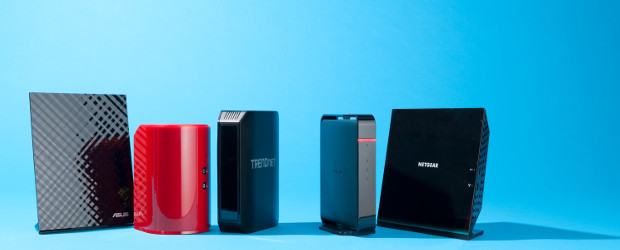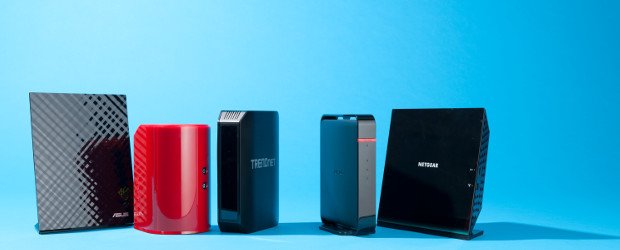Budget AC Router Roundup

Five low-cost 802.11ac routers duke it out
Early adopters should be allowed to wear a special badge in public. That way, we can identify the brave souls who overpaid for immature technology and thank them for fast-pacing the process of getting next-generation hardware out into the market. Without them, we might still be looking at shelves full of overpriced and buggy pre-draft 802.11ac wireless routers, but that’s no longer the case.

Not only has the Wi-Fi Alliance certifi ed the Wireless-AC standard—it’s been nearly a year since it happened—but there are now several entry-level 802.11ac routers available at affordable price points. All of them promise varying levels of increased speed over last generation’s 802.11n standard, and at far less cost—even factoring in the fact that they lack the bells and whistles of their high-end brethren.
But are there compelling reasons to spend more on a higher-end router versus a budget model, or do they all perform pretty much the same? That’s one of the questions we set out to answer, and to do that, we rounded up five low-cost AC routers from Asus (RT-AC52U), D-Link (DIR-818LW), Buffalo (AirStation WHR-1166D), Netgear (R6100), and Trendnet (TEW-813DRU). None of these models cost more than $100 (street pricing) before shipping, but that doesn’t mean we went soft on them. We put each one through the same rigorous tests as we do highend routers. Before we dive into the results, however, we’ll go over in detail what you give up by going the budget route.
Don’t Dodge the Bullet Points
What to look for when buying a budget router
USB Slowdown
If you plan on plugging an external hard drive, fl ash drive, or printer into your router for sharing files or printing over your home network, you’ll want to make sure it has at least one USB port. It’s even better if your router happens to have a USB 3.0 port, though that’s a rare sight in budget territory—every router in this roundup was limited to a single USB 2.0 port (save for one, which didn’t have any USB ports), which means slower fi le transfers from a connected storage device.
Speed Rating
Two of the routers in this roundup are marketed as AC750 models, which means they offer up to 300Mb/s on the 2.4GHz channel and 433Mb/s on the 5GHz channel, while the other three sport AC1200 designations and also offer 300Mb/s on the 2.4GHz channel, but bump up to 867Mb/s on the 5GHz channel. Higher-end routers support faster speeds on both channels—for example, AC1900 routers like the Linksys Smart EA6900 boast up to 600Mb/s on the 2.4GHz channel and 1,300Mb/s on the 5GHz channel. These are all theoretical maximum ratings that are virtually impossible to obtain, but you’ll still see speed gains.
Beamforming Blues
Beamforming is an optional feature of the Wireless-AC standard that allows for concentrating a wireless signal directly at a target device (or multiple target devices) rather than shooting it out haphazardly in every which direction. It’s akin to shining a flashlight at a specific target versus exposing its light bulb. You can usually forget about beamforming support in the budget category—Trendnet’s TEW-813DRU is the only one to support it in this roundup.
LAN and WAN Ports
Virtually all wireless routers these days come with a built-in switch that features four LAN ports. Unfortunately, some router makers still equip lower-end models with 10/100 LAN ports instead of 10/100/1000 (gigabit) LAN ports, and the same goes for WAN. This creates an unnecessary choke point for doling out data, so be sure to pay close attention to the speed rating of both LAN and WAN.
The biggest gaming news, reviews and hardware deals
Keep up to date with the most important stories and the best deals, as picked by the PC Gamer team.
Testing Methodology
Maximum PC Lab Midwest
Testing routers isn’t rocket science, but it can still be tricky business. These days, we test our routers at Maximum PC Lab Midwest. This consists of a 1,400 square-foot home in the suburbs. It’s not an isolated lab environment, but it does allow us to see how routers perform in a real-world scenario.
When the settings allow, we confi gure each router to run in 802.11n-only mode on the 2.4GHz channel and 802.11ac-only mode on the 5GHz channel, both with WPA2 encryption and channel-bonding. More often than not, it isn’t possible to place such tight restrictions on each channel—some will only let you set limits to N+AC, for example—so in those cases, we let the router’s Auto settings confi gure itself for best performance. Depending on the results, we sometimes step in and manually select the best channel, which is something we can determine using Metageek’s inSSIDer tool ($20, www.inssider.com ).
We perform these speed tests in fi ve separate locations, including three inside tests and two outside tests. These include the Bedroom (10 feet from the router, no obstructions), Dining Room (15 feet, 2 walls of separation), and Entryway (20 feet, 3 walls), followed by the two outside tests consisting of the Driveway (35 feet) and Backyard (90 feet).
To measure throughput at each location, we run the open-source Jperf utility, which is a GUI front end for Iperf. For these tests, we hard-wire a desktop to the router to act as the Server, and use a laptop equipped with a Linksys USB6300 dual-band AC USB adapter for the Client PC. And if applicable, we wrap things up by measuring file transfer performance from each router’s USB using a Lexar JumpDrive P10 USB 3.0 flash containing a 3GB file and 1GB folder containing several smaller files.
Since this is a roundup of budget routers, we’re looking for speed relative to price. That’s to say, we don’t expect an $80 AC750 router to perform the same as a $250 AC1900 router. At the same time, we do expect to see speed gains over the 802.11n standard, otherwise there really isn’t any point in purchasing an AC router.
Paul has been playing PC games and raking his knuckles on computer hardware since the Commodore 64. He does not have any tattoos, but thinks it would be cool to get one that reads LOAD"*",8,1. In his off time, he rides motorcycles and wrestles alligators (only one of those is true).


